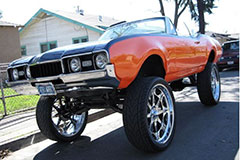Pros and Cons of Low Slung Cars and High Clearance Cars - Vol.437
Which clearance type of car do you prefer? One that's low slung or one that has a high clearance? If you're looking at buying a new car or changing your current one, you may need to consider more than curb appeal.

Movies may make lowered suspension cars look cool. But what are the true benefits of owning a car like that yourself?
Before you make a decision, check out the article below. Find out the pros and cons of both low slung and high clearance cars. And make an informed decision about what's right for your driving preferences.
The Lowdown on a Low Slung Car
Are you thinking of changing the suspension of your car? Or maybe you have your eye on a sleek low-slung sports car? Popular movies have done a lot to boost the appeal of low clearance cars. But there's more to gain than a sexy car. And there may be some disadvantages that you may not have considered.
So, whether you choose to lower your suspension after buying your car, or buy one that's already low slung, there are a few things you should know.
Pros
- Aerodynamic boost
First, you get better aerodynamics in a car with a lowered suspension. Having a low clearance means less air going underneath the car. This translates to less wind drag. And that's why some of the most popular sports cars are low to the ground.
- Better handling and traction
Next, not only do lowered cars look cool. They generally handle a little better, too. This is because the tires have a better grip on the ground with a lower car. It's not always the case, though.
- Reduced risk of rollovers
Any car that's lower to the ground has a lower center of gravity which lowers the risk of rollovers in comparison to higher clearance ones.
- Feels better
Lastly, lowered suspensions may feel better. But that comfort really depends on the individual.
Cons
- Uneven tire wear
Lowered cars can cause uneven tire wear. That's not always the case, but you should watch out for extreme wear patterns in your tires.
- Bottoming out
If you've never heard this term before, it's when the bottom of your vehicle hits the road. This can happen anytime you go over uneven roads, potholes, and speed bumps. Sure, it can cause cosmetic damage to your frame. But even worse is the potential damage it could cause to vulnerable parts of your car's system like the oil pan and exhaust.
- Problems with lifting and towing
Lastly, if you like to manually lift your car for routine maintenance, you may run into some problems. Low slung cars may make it difficult to access the areas that you need. They're also tricky to pull up onto the flatbed tow truck without damaging anything. Your low-strung may come with specialized tow eyes and towing instructions.
The Highs and Lows of a High Clearance Car
Typically, when you think of high clearance cars, it's an SUV, truck, or crossover. These vehicles sit higher off the ground. Some manufacturers purposely make them that way, and some people lift their suspension after buying it. Here's what you need to know about high clearance vehicles:
Pros
- More road presence
First, not only can you see more in a higher clearance car, but others can see you, too. This may give you more time to react to potential dangers on the road.
- Better road resilience
Furthermore, you don't have to worry about bottoming out in a high clearance vehicle. In fact, you may be able to go over surfaces that would normally be off-limits to a car with a standard suspension. This includes rough terrain, curbs, and other obstacles depending on your vehicle type.
Cons
- Increased chance of rollovers
High clearance cars have a higher center of gravity. This translates to a higher risk of rollovers.
- Relatively poor handling
Furthermore, higher clearance can also mean poorer handling in comparison to lower suspension cars, especially around corners.
- Reduced aerodynamics
High clearance vehicles are generally more resilient, but you compromise its aerodynamics. This means you get more wind drag with a higher suspension car, which affects fuel consumption.
Final Thought
Is one type inherently better than the other? Not necessarily. The best type depends on what you plan to use your vehicle for and your own driving style.
So before you go with what looks best, think realistically about how you plan on driving it before you buy it.